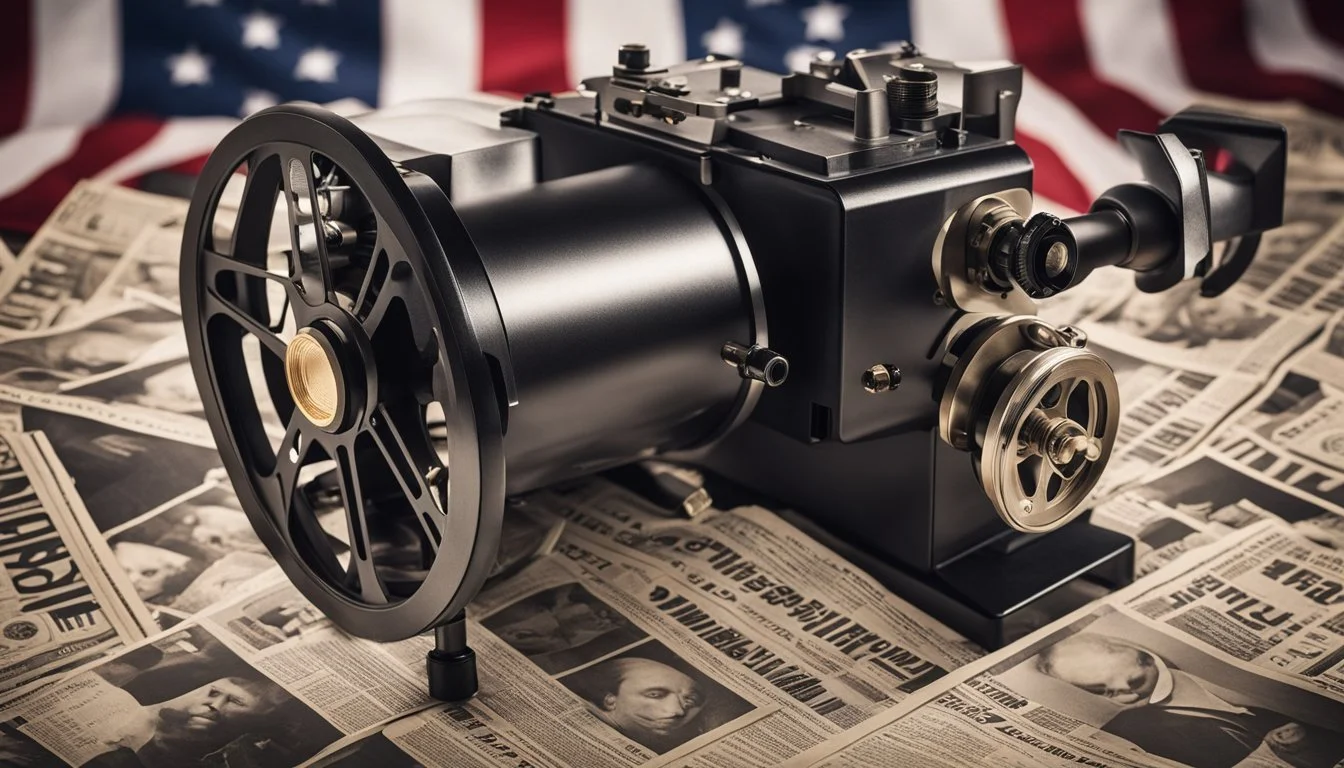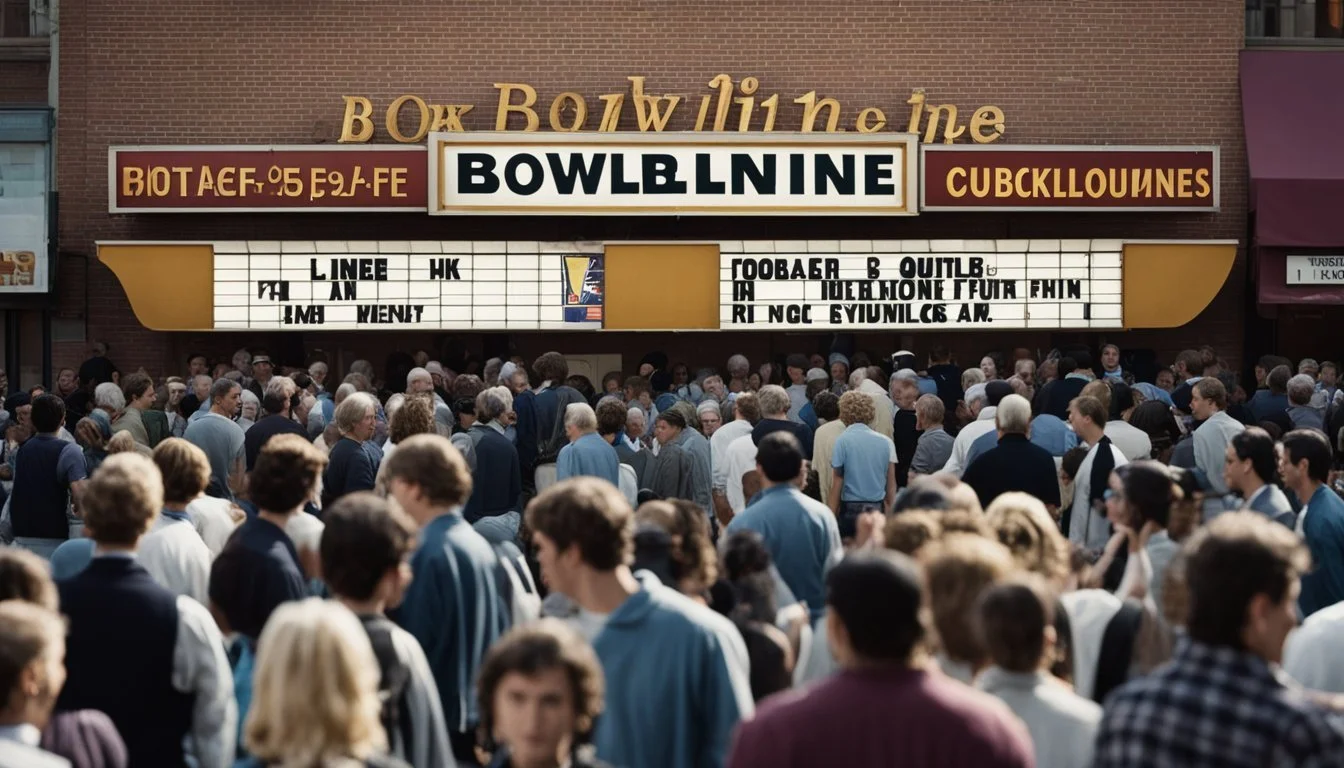Bowling for Columbine Documentary Sparks Debate Over Michael Moore's Controversial Techniques
Michael Moore's documentary "Bowling for Columbine" sparked intense debate upon its release in 2002. The film examines gun violence in America, using the Columbine High School massacre as a focal point. Moore's provocative style and unconventional methods raise questions about documentary filmmaking ethics and objectivity.
"Bowling for Columbine" employs a mix of interviews, archival footage, and Moore's personal commentary to explore the complex factors contributing to gun violence in the United States. The documentary delves into issues of fear, media influence, and gun culture, presenting a multifaceted perspective on a contentious topic.
Critics and audiences alike have grappled with Moore's approach, questioning whether his techniques illuminate important truths or manipulate viewers' emotions. The film's lasting impact and numerous accolades, including an Academy Award for Best Documentary Feature, underscore its significance in the documentary genre and its role in shaping public discourse on gun violence.
Background of 'Bowling for Columbine'
'Bowling for Columbine' emerged as a groundbreaking documentary exploring America's gun culture. The film's context, Moore's prior work, and its place in documentary history shaped its impact and reception.
Contextualizing Columbine High School
On April 20, 1999, Columbine High School in Littleton, Colorado became the site of a tragic massacre. Two students, Eric Harris and Dylan Klebold, killed 13 people and injured 21 others before taking their own lives.
This event shocked the nation and sparked intense debates about gun control, school safety, and youth violence. The massacre's name became synonymous with school shootings, leaving a lasting impact on American culture and policy discussions.
Columbine's proximity to Denver and its suburban setting challenged perceptions of where such violence could occur.
Michael Moore's Filmography
Michael Moore, born in Flint, Michigan, had established himself as a provocative documentarian before 'Bowling for Columbine'. His debut film 'Roger & Me' (1989) explored the impact of General Motors' plant closures on his hometown.
Moore's style blended humor, confrontation, and social commentary. His TV series 'TV Nation' (1994-1995) and 'The Awful Truth' (1999-2000) further honed his approach to tackling complex issues.
'The Big One' (1997) continued Moore's focus on corporate America and worker rights. These projects laid the groundwork for his signature style in 'Bowling for Columbine'.
Evolution of Documentary Filmmaking
'Bowling for Columbine' marked a shift in documentary filmmaking. Traditional documentaries often aimed for objectivity, but Moore embraced a more personal, opinionated approach.
The film's use of animation, archival footage, and confrontational interviews expanded the genre's boundaries. Its commercial success - rare for documentaries at the time - opened doors for more subjective, politically charged films.
Moore's on-screen presence and narrative voice became central to the film's structure. This approach influenced a new generation of documentarians who saw the potential for blending facts with personal perspective.
Content Analysis
Michael Moore's documentary "Bowling for Columbine" employs various techniques to convey its message about gun violence in America. The film combines interviews, archival footage, and satirical elements to provoke thought and discussion.
Dissecting Key Scenes
Moore uses several pivotal scenes to illustrate his points. The opening sequence at a bank offering free guns with new accounts sets the tone for the film's exploration of America's gun culture. This scene blends humor with shock value, highlighting the casual attitude towards firearms.
Another key moment is Moore's visit to Charlton Heston's home. This confrontation serves as the film's climax, showcasing Moore's direct approach to challenging pro-gun arguments. The scene's tension and Heston's discomfort underscore the documentary's controversial nature.
The animated "Brief History of the United States" segment offers a satirical take on American history. This cartoon uses dark humor to critique the country's violent past and present.
Michael Moore's Interview Techniques
Moore's interview style is a defining aspect of the documentary. He often employs a seemingly naive persona to disarm his subjects and elicit candid responses. This technique is evident in his interactions with both gun enthusiasts and victims of gun violence.
His approach can be confrontational, as seen in his impromptu interview with Dick Clark. Moore ambushes Clark to discuss welfare reform, demonstrating his willingness to pursue uncomfortable conversations.
Moore also uses empathy in interviews, particularly with Columbine survivors. These emotional exchanges add depth to the film's examination of gun violence's impact.
Use of Satire and Juxtaposition
Satire is a key tool in Moore's arsenal. He frequently juxtaposes contrasting elements to highlight perceived absurdities in American culture. For example, he compares gun violence statistics in the U.S. to those of other countries, using humor to emphasize the stark differences.
Moore's use of music adds another layer of satire. The choice of Louis Armstrong's "What a Wonderful World" playing over footage of international conflicts critiques American foreign policy.
The film also juxtaposes interviews with ordinary citizens against those with politicians and celebrities. This contrast emphasizes the disconnect between public sentiment and policy decisions regarding gun control.
Sociopolitical Commentary
Michael Moore's "Bowling for Columbine" offers a scathing critique of American gun culture and its societal implications. The film examines the complex interplay between violence, media, and political institutions in shaping public perceptions and policies.
Gun Violence in America
The United States faces a unique challenge with gun violence compared to other developed nations. Moore highlights alarming statistics, showing higher rates of gun-related deaths in America than in countries with similar economic standings.
He explores potential contributing factors, including easy access to firearms and a pervasive culture of fear. The film draws connections between historical events, racial tensions, and the proliferation of guns in American society.
Moore interviews victims of gun violence and their families, putting human faces to the statistics. These personal stories serve to underscore the devastating impact of gun violence on communities across the country.
The NRA's Role and Influence
The National Rifle Association (NRA) features prominently in Moore's analysis of gun culture in America. He examines the organization's political influence and lobbying efforts to protect gun ownership rights.
Moore interviews NRA officials, including then-president Charlton Heston, challenging their stance on gun control measures. The film questions the NRA's interpretation of the Second Amendment and its resistance to firearm regulations.
The documentary explores the NRA's public relations strategies, including its response to mass shootings. Moore critiques the organization's arguments linking gun ownership to personal freedom and safety.
Media and Society's Impact
"Bowling for Columbine" scrutinizes the role of media in shaping public perception of violence and fear. Moore argues that sensationalized news coverage contributes to a climate of anxiety and paranoia.
The film examines how this media-fueled fear may lead to increased gun ownership and a cycle of violence. Moore presents examples of news broadcasts focusing disproportionately on violent crime, potentially skewing viewers' perceptions of danger.
He also explores the influence of violent entertainment, including video games and action movies. The documentary questions whether these media forms contribute to a culture that glorifies violence and desensitizes individuals to its consequences.
Cultural Impact and Public Reception
"Bowling for Columbine" sparked intense debates and garnered significant attention upon its release. The film's provocative approach to gun violence in America resonated with audiences and critics alike.
Critical Acclaim and Controversies
"Bowling for Columbine" received widespread critical acclaim. It won the Special 55th Anniversary Prize at the 2002 Cannes Film Festival and the Academy Award for Best Documentary Feature in 2003. Many praised Moore's blend of humor and serious subject matter.
Critics lauded the film's exploration of America's gun culture and its potential roots in fear. Some viewers found Moore's confrontational style compelling and thought-provoking.
However, the documentary also faced criticism. Detractors accused Moore of manipulating facts and using selective editing to support his arguments. This led to debates about the line between advocacy and journalistic integrity in documentary filmmaking.
Influence on Gun Control Debate
The film reignited discussions about gun control in America. It presented statistics comparing U.S. gun violence rates to other countries, particularly Canada.
Moore's interviews with gun advocates, including Charlton Heston, became talking points in media coverage of the gun debate. The film's exploration of the "culture of fear" concept prompted discussions about media influence on public perception of violence.
"Bowling for Columbine" became a reference point in subsequent gun control debates, with both supporters and opponents citing its arguments and critiques.
Role in Documentary Genre
The film's commercial success helped popularize the documentary genre among mainstream audiences. It grossed over $58 million worldwide, an exceptional figure for a documentary at the time.
Moore's use of humor, pop culture references, and confrontational interviews influenced subsequent documentary filmmakers. The film's style blurred lines between entertainment and journalism, sparking debates about objectivity in documentaries.
"Bowling for Columbine" demonstrated the potential for documentaries to shape public discourse on complex social issues. It paved the way for more politically charged and stylistically daring documentaries in the years that followed.
Profile of Key Figures
Michael Moore's "Bowling for Columbine" features several prominent figures who play crucial roles in shaping the film's narrative and exploration of gun violence in America. These individuals offer diverse perspectives and contribute to the documentary's controversial portrayal of gun culture.
Analyzing Charlton Heston
Charlton Heston, then-president of the National Rifle Association (NRA), emerges as a central figure in Moore's documentary. The film portrays Heston as a staunch defender of gun rights, often shown speaking at pro-gun rallies.
Moore's interview with Heston becomes a pivotal moment in the film. During their exchange, Heston appears uncomfortable with Moore's questioning about gun violence statistics and the NRA's stance on firearms.
The documentary highlights Heston's controversial decision to hold an NRA rally in Littleton, Colorado shortly after the Columbine shooting. This portrayal paints Heston as insensitive to the community's grief and steadfast in his pro-gun beliefs.
Marilyn Manson's Perspective
Marilyn Manson, the controversial rock musician, offers an unexpected viewpoint in the film. Despite being blamed by some for influencing the Columbine shooters, Manson provides thoughtful insights on American culture and violence.
In his interview, Manson critiques media sensationalism and societal fear-mongering. He argues that these factors contribute more to violence than music or entertainment.
Manson's articulate responses challenge preconceived notions about his public persona. His appearance in the film adds depth to the discussion on cultural influences and their alleged links to violent behavior.
Portrayals of Eric Harris and Dylan Klebold
Moore's depiction of Columbine shooters Eric Harris and Dylan Klebold is notably restrained. The film avoids sensationalizing their actions or delving into graphic details of the massacre.
Instead, Moore focuses on the societal and cultural factors that may have influenced Harris and Klebold. He explores their backgrounds, including their participation in a school bowling class on the morning of the shooting.
The documentary examines the ease with which the teenagers obtained firearms. It also questions the role of violent media and video games in shaping their behavior, without drawing definitive conclusions.
Thematic Explorations
Michael Moore's "Bowling for Columbine" delves into complex societal issues through a critical lens. The film examines the interplay between fear, violence, and cultural attitudes in America.
Fear and its Manifestations
Moore's documentary explores how fear permeates American society. He suggests that media sensationalism and political rhetoric amplify public anxieties. The film draws connections between fear and gun ownership, proposing that many Americans arm themselves out of perceived threats.
Moore interviews various individuals to illustrate this point, including members of the Michigan Militia. These segments highlight how fear can drive people to extreme preparedness measures.
The documentary also touches on the impact of terrorism fears post-9/11. It examines how these concerns shape public policy and individual behaviors, often leading to increased gun sales.
The American Psyche and Violence
Moore investigates the relationship between American culture and violence. He questions why the U.S. has higher gun-related death rates compared to other developed nations.
The film explores violent video games, movies, and TV shows as potential factors. However, Moore notes that these media are consumed globally, suggesting deeper cultural issues at play.
He examines historical contexts, including America's frontier mentality and militaristic foreign policy. These elements, Moore argues, contribute to a national psyche that normalizes violence as a problem-solving tool.
Racial Undertones and Gun Ownership
The documentary addresses racial aspects of gun ownership and violence in America. Moore highlights how media portrayals often associate crime with minority communities, particularly African Americans.
He interviews residents in both affluent and low-income areas, revealing disparities in perceptions of safety and gun ownership motivations. The film suggests that racial fears play a significant role in driving gun sales.
Moore also explores how gun control laws have historically targeted minority communities. He presents examples of discriminatory practices in gun licensing and enforcement, raising questions about racial equity in Second Amendment rights.
Comparative Perspectives
Michael Moore's "Bowling for Columbine" examines gun violence through international comparisons, highlighting cultural and policy differences between nations. These contrasts shed light on potential factors influencing violence rates.
United States vs. Canada
Moore explores the stark contrast in gun violence between the United States and Canada. Despite similar gun ownership rates, Canada experiences significantly fewer firearm-related deaths.
The film attributes this difference to several factors:
Stricter gun control laws in Canada
Lower levels of fear and anxiety in Canadian society
More comprehensive social safety nets in Canada
Moore interviews Canadians who leave their doors unlocked, illustrating a perceived sense of security absent in many American communities. This comparison raises questions about cultural attitudes towards safety and the role of media in shaping perceptions of danger.
Global Violence and American Foreign Policy
The documentary expands its scope to examine America's role in global conflicts. Moore draws connections between domestic gun violence and U.S. foreign policy decisions.
Key points include:
U.S. involvement in international conflicts
The impact of arms exports on global violence
Media coverage of foreign interventions
Moore suggests that American military actions abroad may contribute to a culture of violence at home. He presents footage of U.S. interventions in various countries, questioning the motives and consequences of these actions.
The Role of Educational Systems
Education emerges as a crucial factor in shaping societal attitudes towards violence. Moore examines differences in educational approaches between the U.S. and other countries.
The film explores:
Emphasis on critical thinking in schools
Teaching of history and social studies
Integration of conflict resolution skills
Moore interviews educators and students, highlighting how educational systems can influence perceptions of violence and conflict resolution. He suggests that a more comprehensive approach to education might help reduce violent tendencies in society.
Conclusion
Michael Moore's "Bowling for Columbine" remains a controversial yet impactful documentary. The film's examination of gun violence in America sparked intense debates about firearms, culture, and policy.
Moore's unconventional approach blended humor, confrontation, and emotional appeals to engage viewers. His techniques effectively highlighted complex issues, though some criticized his methods as manipulative.
The documentary's focus on the Columbine shooting placed a spotlight on school violence. It prompted discussions about gun control, media influence, and societal factors contributing to such tragedies.
Moore's exploration of American history and politics in relation to gun culture provided context for viewers. He challenged prevailing narratives and encouraged critical thinking about deeply ingrained beliefs.
"Bowling for Columbine" left a lasting impact on documentary filmmaking and public discourse. It demonstrated the power of cinema to shape conversations on pressing social issues.
While opinions on Moore's work remain divided, the film's influence on discussions about gun-related violence is undeniable. It continues to provoke thought and debate years after its release.








